Not Every Day Is a Walk in the Park
Y’all. It. Is. Hot. I’ve been watching heat advisories crop up all over the country, some of which are lasting a week or more.
I’m lucky because both my dogs and I love the heat. When it is 80 out, we’re living our best lives. In fact, my dogs will bully me to go outside whenever they see that I’m not fully focused when the summer weather is in full effect.
But as I said, we’re lucky. Many of my clients and their pets struggle this time of year. Depending on where you live, keeping dogs cool can be challenging, especially if they are heat-intolerant. We see changes in many dogs’ behavior in hot weather. For some, meeting their dog’s physical exercise needs gets challenging, and for others, creating a cooling space for their dog feels impossible. For some, their dog’s rest and sleep routine is disrupted, and boy-oh-boy, sleep is important. And, as someone who has lived in very hot climates, this isn’t even taking into account the impact the heat has on humans, which is nothing to scoff at.
Either way, creating a cooling space for dogs and other pets is an important part of your dog’s summertime enrichment strategy. Both indoors and out, we’re able to look at small adjustments that may make a big difference for the health, safety, and comfort of our dogs, pets, and even maybe us!
Why Cooling Spaces Matter
Being able to regulate one’s body temperature is important. I think any of us who have been in a place that is too hot or too cold for our comfort can understand. The risks associated with it can range from being snappy, irritable, and unrested to critical health emergencies. Check out last week’s blog if you want to know more about how dogs thermoregulate why heat stroke is such a big deal.
Humans have developed all sorts of strategies to help us on both ends of the spectrum, heaters, special clothing, air conditioning, fans, adjusted schedules to avoid the peak heat…but our pets don’t have so many gadgets and gizmos available to them.
Shoot, most creatures on this planet can’t even sweat, including dogs, cats, and birds, which can lead to even greater sensitivity to heat. So, while for some of us the heat is a reprieve from the cold of winter, it can be incredibly dangerous for others. Knowing the risk factors for your specific pet can help you develop your summer enrichment strategies to meet everyone’s needs.
Certain traits make cooling down more difficult. If your dog has one (or more) of these traits, they may be particularly susceptible to overheating, experiencing heat-related illnesses, or suffering from heatstroke:
- Short snouts and smushed faces: brachycephalic dogs have shorter airways and dissipate heat less efficiently
- Dark, thick, or double coats: absorb heat easily, and their thick hair can insulate and retain heat, making it harder to dissipate, especially if it is matted
- Advanced age: Senior dogs may have poor circulation, resulting in poor heat regulation
- Youngsters: Puppies have underdeveloped heat regulation systems
- Health issues: Including obesity, and particularly those issues that affect the airways, heart, or lungs
Keep in mind, sometimes we do things that aren’t good for us. So, just like all other enrichment strategies, we need to trial and eval. I adore being outside in the warm sun, AND know that I burn at the whisper of UV rays. You’d think that my history with sunburns would have impacted my desire to be out in the sun, but it hasn’t.
What Makes a Great Cooling Space?
So, what do we trial and eval? There are a ton of options! I always recommend looking for things you already have available rather than getting something new, but there are times when we may want or need to invest.
Growing up and currently residing in the Pacific Northwest, air conditioning isn’t a standard feature in homes. Growing up, I can’t remember a single family central AC. While it is becoming more common as we’re getting hotter and hotter summers, it is a gigantic investment that I’m not going to ask a pet parent to get, unless it is already in the plans, and they own the property. So, while getting AC installed is an option, let’s focus on items that have a lower cost of entry.
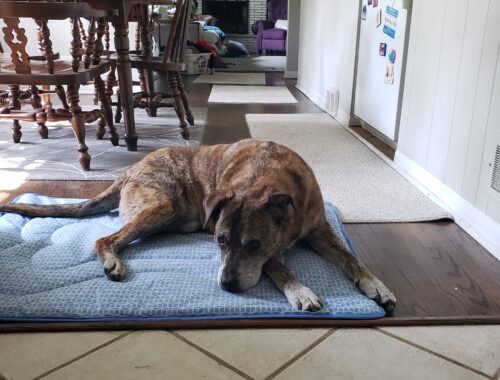
Can we create a cool surface?
Tile, stone, linoleum, vinyl, really anything other than carpet tends to be cooler than carpet. Is there a place that your pup can lie on that is a cooler floor?
If you’re outside, a damp towel or a shallow pool can be a way to create a cooler space. (Make sure it is in the shade, or you’re regularly rotating the water if it is in the sun.)
Cooling mats can be an excellent option for pups that like to lie on cool things. I sat on one the other day and it gave me chills! Keep in mind that these tend to “lose their cool” until the dog gets up and allows the heat to dissipate again, so sometimes families opt to get two or three.
For pups that aren’t a fan of cooling mats, but may like something like stone, a stone bathmat has been an option that many clients report their pups like.
I’ve had families go to the hardware store, either get the materials to make a metal “bed” structure for their pets or a steel shelving unit. This really depends on their baseline level of building skill or the skill of someone in their lives. Having a smooth sheet of metal raised a few inches off the ground can be a really nice, cold spot to lie down for a hot dog.
Can we increase ventilation or air circulation?
Fans, either box, oscillating, ceiling, or other, really anything that gets the air moving can be helpful, both inside or out. Some dogs are going to want to lie down right in front of them, while other dogs loathe the feeling of air blowing on them. Remember, we want the enrichment to be something they engage in, so trial and eval your dog’s preferences.
AC units, either window units, single room units, full house units, or even DIY swamp coolers are all options depending on your home and your resources. Sometimes you don’t need to cool the whole house, just a small area.
In the Pacific Northwest, where we don’t have a lot of AC, we default to having two states of the house: evening/night, crack every window you safely can, and day, close all the curtains, all the blinds, and pretend you live in a dark dungeon. If it is cooler outside than in, getting some air flow from outside can help bring down the temperature.
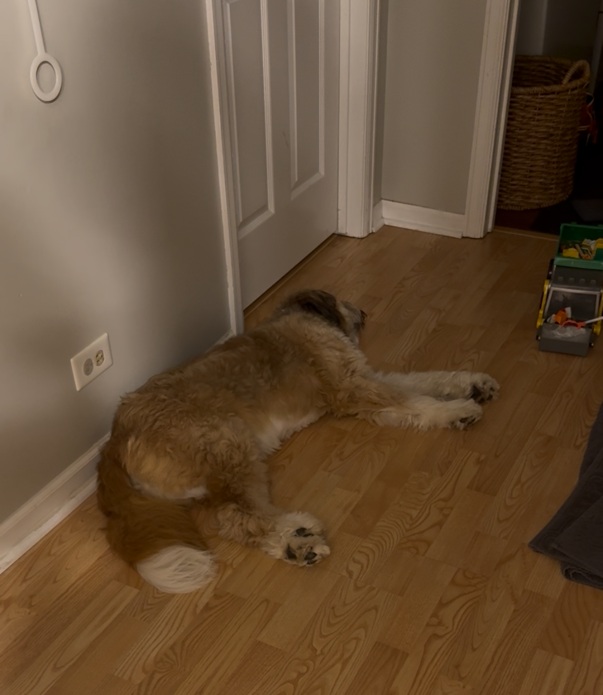
Can we reduce extra stimulation?
Can we turn the lights off, reduce foot traffic, or overall create a quiet area for our pup to calm and cool? While some things may not elicit anxiety or fear, they may still be irritating to our pets, and disruptive to that peaceful space we’re looking for. Eileen Anderson talks about tolerance in this fantastic blog.
Can we increase shade?
We have curtains in our bedroom that are touted to be both sound-dampening and to prevent heat transfer in and out of the windows. During the day, when the sun is high, we can close those curtains to keep the heat out.
Outside, utilizing things like umbrellas, shade cloth structures, and long-term strategic planting can be great ways to increase shade in your space.
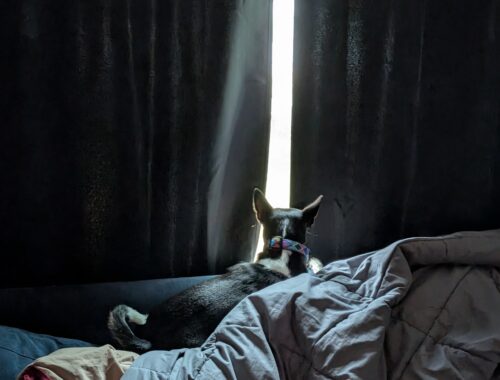
Can we use additional cooling aids?
Frozen treats in the space can be a way to keep our pets’ activity level lower, help them stay in the cooler area, and provide them with that cool, little sweet treat during the peak of the heat. Stay tuned for next week’s blog, where Claire will have some suggestions for stuffed frozen
Back when I worked in zoological, wildlife rehab, and outdoor dog daycare, we would leverage exterior mist systems to help cool the ambient air outside. It doesn’t need to be fancy or permanent (unless that makes sense for your life), it can be simple, like this one.
DIY Chill Zones: Options for Every Home
Remember to test the elements one by one to see how your pet feels about them. They may love 90% of the setup, but really, really, dislike 10%. That doesn’t mean the 90% won’t work, we just need to adjust!
I know, I just gave you a ton of options, and that can be overwhelming, so here are some selections that piece elements together:
- Creating a shaded area on your patio with a raised dog bed and a plastic water bowl.
- Setting up their crate in a quiet bedroom with a cooling mat next to it, and a fan blowing on a different dog bed.
- Creating a cooled office space, with a single-room AC unit, a dog bed, and blackout curtains.
- Pushing the kitchen table to the side, giving them a station under the kitchen table on the stone floor with a water bowl, or a frozen licky.
What works for you and your pet is going to depend on what you both like, what you already have available, and what your current space already looks like.
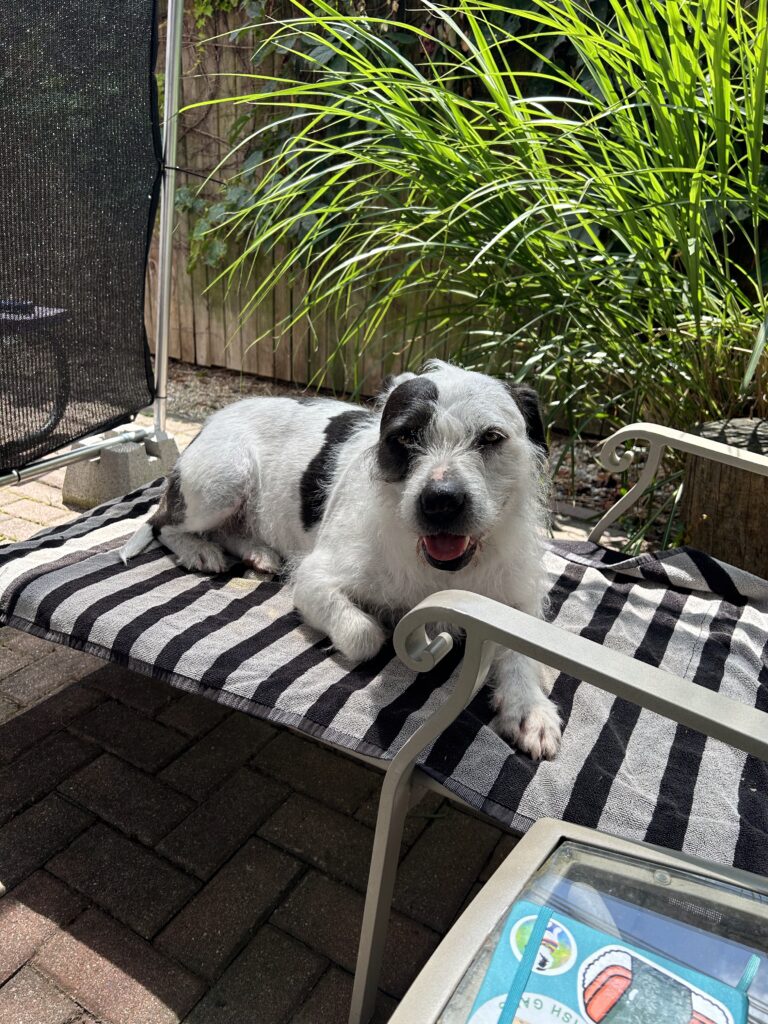
Making the Cooling Space Appealing
Building the space is only part of the process; we may need to teach our pet that it is a place they want to spend time!
Sure, we may get lucky with a dog that gets the look on their face that says, “WHERE HAS THIS BEEN MY WHOLE LIFE!?” Or, we may have a pup that is so amped from the heat that they are going to need help to feel the relief before they are going to be bought into the whole idea.
Depending on what the space entails, you may need to teach things like go to spot, or you may need to build a positive association with things like foraging toys, or quality time together.
Keep in mind, we’re merely giving suggestions; we aren’t forcing our pets to use the spot. Take the time to observe what your pet is doing and think of little changes you could make. I know Laika loves to be on the highest, cushiest spot in the house. If I needed to create a cooler space for her, it wouldn’t include a cooling mat. Sure, I could take the time to teach it, but that isn’t a good use of our time, energy, or effort.
Supporting Cool-Down Behavior Throughout the Day
Enrichment is about increasing welfare and well-being, and that includes rest. It may seem like your pet isn’t getting “enough” in the summer, but across many species in the animal kingdom, it is normal to primarily rest in the peak of the heat.
Getting adequate rest is so, so, so important, and helping our pets to wind down after an activity in a way that is safe, and helps their body return to baseline is enrichment.
So, you may want to teach your pet that in the summer, activity -> cool zone time.
Years ago, I had the opportunity to work with an incredible family and their pup, Bart. Bart ran hot. Like so, so, so hot. And when Bart was hot, Bart became a parkour fiend. Which may be fine, except Bart was also a tank on legs, and really didn’t have the greatest sense of personal space.
In the peak of the summer, Bart was really struggling to settle. He wanted to go, go, go, go, go, go… which was not feasible for his people, or safe for him.
We worked on helping Bart create a cooling station, and after his normal cup-filling activities, we worked on going to the cooling station for recovery. We had to start by teaching Bart to use the cooling mat and by spending time with him while his body transitioned from the activity.
Gradually, with practice, Bart would come in, run to his mat, and wait for his person to turn on the fan. It was a beautiful change from Bulldozer Bart barreling through the house!
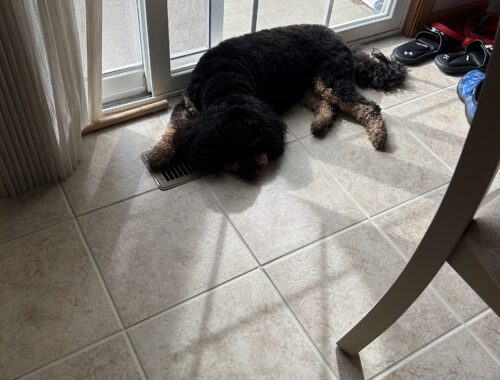
When to Worry: Cooling Spaces Are Support, Not Treatment
As I mentioned at the beginning of this blog, heat can truly be dangerous. Cooling spaces are intended to help you prevent problems, not treat them. Please familiarize yourself with the signs and risks of heatstroke, and seek medical attention if your pet does overheat.
Here’s to harmony,
Ellen
Now What?
Now it’s time to trial and eval your pet’s cooling station! Take a walk around your home with your pet in mind. Is there a place that would be an excellent cooling spot? Is there a space outside that would benefit from a little extra cooling effort?
Take one small step toward change today, and see how your pet feels about it. Do you have a fan camper, or a dog that avoids blowing air at all costs? Do you have a dog that splays out on the cold floor, or a dog that you’ve never seen lie down on a cold spot?
Make one small change at a time so you can assess how your pet feels. And as always, share your findings and your pet’s summer retreat with us!
Copyright 2025 Pet Harmony, LLC. All Rights Reserved.
Terms & Conditions, Privacy Policy
Results are not guaranteed because behavior, human, canine, or otherwise, are not guaranteeable.


